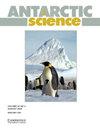南极belica antarctica Jacobs的染色体图谱(双翅目:手蛾科),包括染色体变异
IF 2
4区 地球科学
Q3 ENVIRONMENTAL SCIENCES
引用次数: 0
摘要
摘要/ Abstract摘要:Belgica antarctica Jacobs(双翅目:手蛾科)是南极半岛地区唯一的特有种昆虫,引起了广泛的研究兴趣。由于最近南极洲区域气候的迅速变化,人们对研究这一物种对环境变化的反应,特别是在染色体水平上的反应越来越感兴趣。众所周知,染色体倒位在许多昆虫物种的物种形成和适应中起着重要作用,但它们在自然种群中的频率却知之甚少。在当前的研究中,我们提供了第一个标准多线染色体为b .南极地图,这将使未来的研究染色体异常的的精确位置。我们进一步分析了在南极半岛西海岸阿根廷群岛加林德兹岛两个不同地点采集的四龄幼虫的染色体多态性。我们发现了四个先前报道的和两个新的遗传反转,并讨论了它们在应对南极半岛地区环境压力方面可能的适应性作用。我们的研究结果为进一步探索南极南极冰杆菌染色体多态性在适应环境变化中的潜在作用奠定了基础。本文章由计算机程序翻译,如有差异,请以英文原文为准。
A chromosome map of Belgica antarctica Jacobs (Diptera: Chironomidae) from Antarctica, including chromosome variability
Abstract Belgica antarctica Jacobs (Diptera: Chironomidae) is the only endemic insect found in the Antarctic Peninsula region and has stimulated considerable research interest. Due to recent rapid changes in regional climate in Antarctica, there is growing interest in studying the responses of this species to environmental changes, in particular at the chromosomal level. Chromosomal inversions are known to play an important role in speciation and adaptation in many insect species, but their frequencies in natural populations are poorly understood. In the current study, we provide the first standard polytene chromosome map for B. antarctica , which will enable the precise location of chromosomal abnormalities in future studies. We further analysed chromosomal polymorphisms in fourth-instar larvae collected from two different locations on Galindez Island, Argentine Islands, western coast of the Antarctic Peninsula. We found four previously reported and two new inherited inversions, and we discuss their possible adaptive role in response to environmental stressors in the Antarctic Peninsula region. Our data provide a foundation for future studies exploring the potential role of B. antarctica chromosomal polymorphisms in adaptation to the changing environment.
求助全文
通过发布文献求助,成功后即可免费获取论文全文。
去求助
来源期刊

Antarctic Science
地学-地球科学综合
CiteScore
3.60
自引率
6.20%
发文量
42
审稿时长
3 months
期刊介绍:
Antarctic Science provides a truly international forum for the broad spread of studies that increasingly characterise scientific research in the Antarctic. Whilst emphasising interdisciplinary work, the journal publishes papers from environmental management to biodiversity, from volcanoes to icebergs, and from oceanography to the upper atmosphere. No other journal covers such a wide range of Antarctic scientific studies. The journal attracts papers from all countries currently undertaking Antarctic research. It publishes both review and data papers with no limits on length, two-page short notes on technical developments and recent discoveries, and book reviews. These, together with an editorial discussing broader aspects of science, provide a rich and varied mixture of items to interest researchers in all areas of science. There are no page charges, or charges for colour, to authors publishing in the Journal. One issue each year is normally devoted to a specific theme or papers from a major meeting.
 求助内容:
求助内容: 应助结果提醒方式:
应助结果提醒方式:


